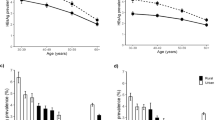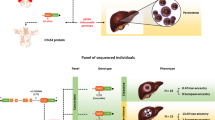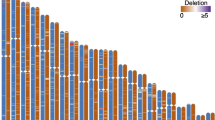Abstract
Chronic hepatitis B virus (HBV) infection is a challenging global health problem. To identify genetic loci involved in chronic HBV infection, we designed a three-phase genome-wide association study in Han Chinese populations. The discovery phase included 951 HBV carriers (cases) and 937 individuals who had naturally cleared HBV infection (controls) and was followed by independent replications with a total of 2,248 cases and 3,051 controls and additional replications with 1,982 HBV carriers and 2,622 controls from the general population. We identified two new loci associated with chronic HBV infection: rs3130542 at 6p21.33 (near HLA-C, odds ratio (OR) = 1.33, P = 9.49 × 10−14) and rs4821116 at 22q11.21 (in UBE2L3, OR = 0.82, P = 1.71 × 10−12). Additionally, we replicated the previously identified associations of HLA-DP and HLA-DQ variants at 6p21.32 with chronic HBV infection. These findings highlight the importance of HLA-C and UBE2L3 in the clearance of HBV infection in addition to HLA-DP and HLA-DQ.
This is a preview of subscription content, access via your institution
Access options
Subscribe to this journal
Receive 12 print issues and online access
$209.00 per year
only $17.42 per issue
Buy this article
- Purchase on SpringerLink
- Instant access to full article PDF
Prices may be subject to local taxes which are calculated during checkout

Similar content being viewed by others
References
Liaw, Y.F. & Chu, C.M. Hepatitis B virus infection. Lancet 373, 582–592 (2009).
Sener, S.F. Disease without borders. CA Cancer J. Clin. 55, 7–9 (2005).
Jemal, A. et al. Global cancer statistics. CA Cancer J. Clin. 61, 69–90 (2011).
Custer, B. et al. Global epidemiology of hepatitis B virus. J. Clin. Gastroenterol. 38, S158–S168 (2004).
Beasley, R.P., Hwang, L.Y., Lin, C.C. & Chien, C.S. Hepatocellular carcinoma and hepatitis B virus. A prospective study of 22 707 men in Taiwan. Lancet 2, 1129–1133 (1981).
He, Y.L., Zhao, Y.R., Zhang, S.L. & Lin, S.M. Host susceptibility to persistent hepatitis B virus infection. World J. Gastroenterol. 12, 4788–4793 (2006).
Kamatani, Y. et al. A genome-wide association study identifies variants in the HLA-DP locus associated with chronic hepatitis B in Asians. Nat. Genet. 41, 591–595 (2009).
Mbarek, H. et al. A genome-wide association study of chronic hepatitis B identified novel risk locus in a Japanese population. Hum. Mol. Genet. 20, 3884–3892 (2011).
Nishida, N. et al. Genome-wide association study confirming association of HLA-DP with protection against chronic hepatitis B and viral clearance in Japanese and Korean. PLoS ONE 7, e39175 (2012).
Green, M.S. et al. Use of predictive value to adjust relative risk estimates biased by misclassification of outcome status. Am. J. Epidemiol. 117, 98–105 (1983).
Han, Y. et al. Association of human leukocyte antigen–DRB1 alleles with chronic hepatitis B virus infection in the Han Chinese of Northeast China. Mol. Med. Rep. 5, 1347–1351 (2012).
Li, X. et al. The influence of HLA alleles and HBV subgenotyes on the outcomes of HBV infections in Northeast China. Virus Res. 163, 328–333 (2012).
Kummee, P. et al. Association of HLA-DRB1*13 and TNF-α gene polymorphisms with clearance of chronic hepatitis B infection and risk of hepatocellular carcinoma in Thai population. J. Viral Hepat. 14, 841–848 (2007).
Zeller, T. et al. Genetics and beyond—the transcriptome of human monocytes and disease susceptibility. PLoS ONE 5, e10693 (2010).
Pique-Regi, R. et al. Accurate inference of transcription factor binding from DNA sequence and chromatin accessibility data. Genome Res. 21, 447–455 (2011).
An, P., Winkler, C., Guan, L., O'Brien, S.J. & Zeng, Z. A common HLA-DPA1 variant is a major determinant of hepatitis B virus clearance in Han Chinese. J. Infect. Dis. 203, 943–947 (2011).
Guo, X. et al. Strong influence of human leukocyte antigen (HLA)-DP gene variants on development of persistent chronic hepatitis B virus carriers in the Han Chinese population. Hepatology 53, 422–428 (2011).
Hu, L. et al. Genetic variants in human leukocyte antigen/DP-DQ influence both hepatitis B virus clearance and hepatocellular carcinoma development. Hepatology 55, 1426–1431 (2012).
Li, J. et al. Associations of HLA-DP variants with hepatitis B virus infection in southern and northern Han Chinese populations: a multicenter case-control study. PLoS ONE 6, e24221 (2011).
Thomas, R. et al. A novel variant marking HLA-DP expression levels predicts recovery from hepatitis B virus infection. J. Virol. 86, 6979–6985 (2012).
Vermehren, J. et al. A common HLA-DPA1 variant is associated with hepatitis B virus infection but fails to distinguish active from inactive Caucasian carriers. PLoS ONE 7, e32605 (2012).
Wang, L. et al. Evaluation of genetic susceptibility loci for chronic hepatitis B in Chinese: two independent case-control studies. PLoS ONE 6, e17608 (2011).
O'Brien, T.R. et al. Risk alleles for chronic hepatitis B are associated with decreased mRNA expression of HLA-DPA1 and HLA-DPB1 in normal human liver. Genes Immun. 12, 428–433 (2011).
Thio, C.L. et al. Class II HLA alleles and hepatitis B virus persistence in African Americans. J. Infect. Dis. 179, 1004–1006 (1999).
Díaz, G. et al. Functional analysis of HLA-DP polymorphism: a crucial role for DPβ residues 9, 11, 35, 55, 56, 69 and 84–87 in T cell allorecognition and peptide binding. Int. Immunol. 15, 565–576 (2003).
Chang, J.J. et al. Reduced hepatitis B virus (HBV)-specific CD4+ T-cell responses in human immunodeficiency virus type 1-HBV-coinfected individuals receiving HBV-active antiretroviral therapy. J. Virol. 79, 3038–3051 (2005).
Dubois, P.C. et al. Multiple common variants for celiac disease influencing immune gene expression. Nat. Genet. 42, 295–302 (2010).
Fransen, K. et al. Analysis of SNPs with an effect on gene expression identifies UBE2L3 and BCL3 as potential new risk genes for Crohn's disease. Hum. Mol. Genet. 19, 3482–3488 (2010).
Hüffmeier, U. et al. Common variants at TRAF3IP2 are associated with susceptibility to psoriatic arthritis and psoriasis. Nat. Genet. 42, 996–999 (2010).
Wang, S. et al. A functional haplotype of UBE2L3 confers risk for systemic lupus erythematosus. Genes Immun. 13, 380–387 (2012).
Zhernakova, A. et al. Meta-analysis of genome-wide association studies in celiac disease and rheumatoid arthritis identifies fourteen non-HLA shared loci. PLoS Genet. 7, e1002004 (2011).
Ballardini, G. et al. HLA-A,B,C, HLA-D/DR and HLA-D/DQ expression on unfixed liver biopsy sections from patients with chronic liver disease. Clin. Exp. Immunol. 70, 35–46 (1987).
Zhang, Y. et al. Hepatitis B virus core antigen epitopes presented by HLA-A2 single-chain trimers induce functional epitope-specific CD8+ T-cell responses in HLA-A2.1/Kb transgenic mice. Immunology 121, 105–112 (2007).
Chen, W. et al. HBcAg-pulsed dendritic cell vaccine induces Th1 polarization and production of hepatitis B virus–specific cytotoxic T lymphocytes. Hepatol. Res. 39, 355–365 (2009).
Chen, J.H. et al. Ubiquitin conjugation of hepatitis B virus core antigen DNA vaccine leads to enhanced cell-mediated immune response in BALB/c mice. Hepat. Mon. 11, 620–628 (2011).
Montgomery, S.B. et al. Transcriptome genetics using second generation sequencing in a Caucasian population. Nature 464, 773–777 (2010).
Moynihan, T.P. et al. Fine-mapping, genomic organization, and transcript analysis of the human ubiquitin-conjugating enzyme gene UBE2L3. Genomics 51, 124–127 (1998).
Staib, F., Hussain, S.P., Hofseth, L.J., Wang, X.W. & Harris, C.C. TP53 and liver carcinogenesis. Hum. Mutat. 21, 201–216 (2003).
Norton, P.A. et al. Activation of fibronectin gene expression by hepatitis B virus x antigen. J. Viral Hepat. 11, 332–341 (2004).
Bertoletti, A. et al. Innate and adaptive immune responses in chronic hepatitis B virus infections: towards restoration of immune control of viral infection. Gut 61, 1754–1764 (2012).
Li, S. et al. GWAS identifies novel susceptibility loci on 6p21.32 and 21q21.3 for hepatocellular carcinoma in chronic hepatitis B virus carriers. PLoS Genet. 8, e1002791 (2012).
Du, G. et al. Sero-epidemiological surveys of hepatitis B in different populations in Zhangjiagang city. Mod. Prev. Med. 23, 4560–4563 (2009).
Fang, Y. et al. Investigation of the serum markers of hepatitis B virus among 2378 physical examination takers in Shanghai. Occup. Health (Lond.) 4, 350–351 (2008).
Liang, X. et al. Epidemiological serosurvey of hepatitis B in China—declining HBV prevalence due to hepatitis B vaccination. Vaccine 27, 6550–6557 (2009).
Purcell, S. et al. PLINK: a tool set for whole-genome association and population-based linkage analyses. Am. J. Hum. Genet. 81, 559–575 (2007).
Price, A.L. et al. Principal components analysis corrects for stratification in genome-wide association studies. Nat. Genet. 38, 904–909 (2006).
Delaneau, O., Marchini, J. & Zagury, J.F. A linear complexity phasing method for thousands of genomes. Nat. Methods 9, 179–181 (2012).
Acknowledgements
The authors thank all study subjects, research staff and students who participated in this work and Z. Wang (US National Cancer Institute) for statistical help with imputation. This work was funded by the National Key Basic Research Program (2013CB911400), the project supported by the National Science Foundation for Distinguished Young Scholars of China (81225020), the project supported by the State Key Program of National Natural Science of China (81230067), the Foundation for the Program for New Century Excellent Talents in University (NCET-10-0178), the Author of National Excellent Doctoral Dissertation (201081), the National Natural Science Foundation of China (30800946 and 81072344), the State Key Infectious Disease Project of China (2012ZX10002010 and 2012ZX10002016), the National Major Science & Technology Project (2011ZX10004-902), the National Science Fund for Creative Research Groups (30921006), the National Key Basic Research Program (2013CB910304), a China National High-Tech Research and Development Program grant (2012AA02A515), the Foundation for Distinguished Young Scholars of Jiangsu Province (BK2012042 and BK20130042) and the Priority Academic Program for the Development of Jiangsu Higher Education Institutions (Public Health and Preventive Medicine).
Author information
Authors and Affiliations
Contributions
H.S. and Z.H. directed the study, obtained financial support and were responsible for study design, interpretation of the results and manuscript writing together with W.Z. and Y.S. Z.H. performed overall project management along with Y.L., G.J. and X.Z. and drafted the initial manuscript. J.D. performed statistical analyses along with Y.L. Y.L., M. Chu, J.W., Y.H. and K.X. were responsible for sample processing and managing the genotyping data. Y.Y. and Y.H. were responsible for subject recruitment and sample preparation for the Shanghai samples. X.Z., L.Z., G.D., Q.W., H.Y. and M. Cao were responsible for subject recruitment and sample preparation for the Zhangjiagang and Changzhou samples. X.Z., Y.Z. and J.W. were responsible for subject recruitment and sample preparation for the Taizhou samples. Jibin Liu, L.L. and K.X. were responsible for subject recruitment and sample preparation for the Nantong samples. L.W., G.Z. and Y.W. were responsible for subject recruitment and sample preparation for the Beijing samples. W.J., S.L. and J. Lu were responsible for subject recruitment and sample preparation for the Guangdong samples. Jianjun Liu provided technical and material support. All authors approved the final manuscript.
Corresponding authors
Ethics declarations
Competing interests
The authors declare no competing financial interests.
Supplementary information
Supplementary Text and Figures
Supplementary Figures 1–4 and Supplementary Tables 1–9 (PDF 1472 kb)
Rights and permissions
About this article
Cite this article
Hu, Z., Liu, Y., Zhai, X. et al. New loci associated with chronic hepatitis B virus infection in Han Chinese. Nat Genet 45, 1499–1503 (2013). https://doi.org/10.1038/ng.2809
Received:
Accepted:
Published:
Issue Date:
DOI: https://doi.org/10.1038/ng.2809
This article is cited by
-
Polymorphisms within DIO2 and GADD45A genes increase the risk of liver disease progression in chronic hepatitis b carriers
Scientific Reports (2023)
-
Conventional and genetic risk factors for chronic Hepatitis B virus infection in a community-based study of 0.5 million Chinese adults
Scientific Reports (2022)
-
Genome-wide copy number variation analysis of hepatitis B infection in a Japanese population
Human Genome Variation (2021)
-
Trans-ethnic genome-wide association study of severe COVID-19
Communications Biology (2021)
-
Genetic association study of interferon lambda 3, CD27, and human leukocyte antigen-DPB1 with dengue severity in Thailand
BMC Infectious Diseases (2020)



